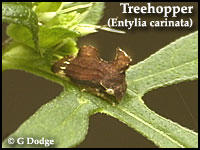 I discovered a treehopper on Common Ragweed near the Wetlands Overlook next to the Lemur House. The only name I could find for it is the binomial or scientific name Entylia carinata, but since carinata means “keeled,” a good common name might be Keeled Treehopper. The “keel” in the name apparently refers to the projections on the head and back of the insect. These treehoppers are looked after by ants, apparently for the honeydew produced by the hoppers. There were several ants nearby when I shot the picture at left. (See also Treehoppers, Explore the Wild Journal, August 1-15.)
I discovered a treehopper on Common Ragweed near the Wetlands Overlook next to the Lemur House. The only name I could find for it is the binomial or scientific name Entylia carinata, but since carinata means “keeled,” a good common name might be Keeled Treehopper. The “keel” in the name apparently refers to the projections on the head and back of the insect. These treehoppers are looked after by ants, apparently for the honeydew produced by the hoppers. There were several ants nearby when I shot the picture at left. (See also Treehoppers, Explore the Wild Journal, August 1-15.)
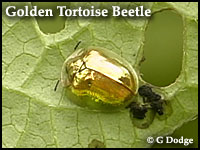 I was finally able to get a picture of a “golden” Golden Tortoise Beetle (image at right). These beetles usually hang out under Morning Glory leaves and either fly away or rapidly change colors as soon as they’re disturbed, so I’ve had a bit of trouble getting an image of one in golden mode, until now. (See Explore the Wild Journal, August 16-31.)
I was finally able to get a picture of a “golden” Golden Tortoise Beetle (image at right). These beetles usually hang out under Morning Glory leaves and either fly away or rapidly change colors as soon as they’re disturbed, so I’ve had a bit of trouble getting an image of one in golden mode, until now. (See Explore the Wild Journal, August 16-31.)
While resting on a bench and having a look about, I noticed something beetle-like crossing the paved path through Catch the Wind. I scooped it up just before it disappeared into the grass at the edge of the path. I photographed it at home, later releasing it. I’m not quite positive of its identity but am confident it belongs to a subfamily of weevils known as Broad-nosed Weevils (Entiminae).
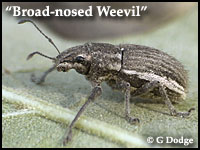 Most weevils have long pointy snouts. These guys do not. This one is flightless, or at least, it made no attempt to fly away. One way to distinguish weevils from beetles (if they don’t have a long pointed snout) is that weevils have “elbowed” antennae. The image here doesn’t show this feature well, but if you look closely you can see a small enlarged area about halfway up the right antenna (not the crook at the tip). The antenna bends forward at that little “bump” in the antenna.
Most weevils have long pointy snouts. These guys do not. This one is flightless, or at least, it made no attempt to fly away. One way to distinguish weevils from beetles (if they don’t have a long pointed snout) is that weevils have “elbowed” antennae. The image here doesn’t show this feature well, but if you look closely you can see a small enlarged area about halfway up the right antenna (not the crook at the tip). The antenna bends forward at that little “bump” in the antenna.
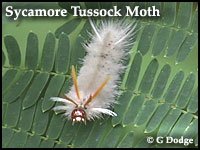 Tussock moths can show up just about anywhere at this time of year so it was no surprise to see a Sycamore Tussock Moth Caterpillar near the back side of the Loop between Catch the Wind and Explore the Wild. It was, however, a bit of a surprise to see it crawling along on a Mimosa Leaf (image here).
Tussock moths can show up just about anywhere at this time of year so it was no surprise to see a Sycamore Tussock Moth Caterpillar near the back side of the Loop between Catch the Wind and Explore the Wild. It was, however, a bit of a surprise to see it crawling along on a Mimosa Leaf (image here).
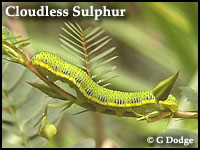 Two tiny Cloudless Sulphur Caterpillars were observed on the Partridge Pea near the culvert on the backside of the Loop between Catch the Wind and Explore the Wild (see Partridge Pea, Explore the Wild Journal, August 16-31). They were initially seen during the first few days of this period. Those individuals apparently have crawled away to pupate; I couldn’t locate them after 10 September. There are Cloudless Sulphurs flying through the area every day so keep an eye out for more caterpillars. Partridge Pea grows alongside the path at several locations throughout the Explore the Wild/Catch the Wind Loop. While searching, don’t be fooled by the seed pods of the plant; they can look surprisingly like the caterpillars, or should I say, the caterpillars look like the pods.
Two tiny Cloudless Sulphur Caterpillars were observed on the Partridge Pea near the culvert on the backside of the Loop between Catch the Wind and Explore the Wild (see Partridge Pea, Explore the Wild Journal, August 16-31). They were initially seen during the first few days of this period. Those individuals apparently have crawled away to pupate; I couldn’t locate them after 10 September. There are Cloudless Sulphurs flying through the area every day so keep an eye out for more caterpillars. Partridge Pea grows alongside the path at several locations throughout the Explore the Wild/Catch the Wind Loop. While searching, don’t be fooled by the seed pods of the plant; they can look surprisingly like the caterpillars, or should I say, the caterpillars look like the pods.